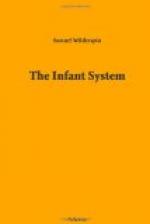A.
Q. Where am I? A. Opposite to us. Q. What is on the right side of me? A. A lady. Q. What is on the left side of me? A. A chair. Q. What is before me? A. A desk. Q. Who is before me? A. We, children. Q. What do I hold up in my hand? A. A letter A.Q. What word begins with A? A. Apple. Q. Which hand do I hold it up with? A. With the right hand. Q. Spell apple.[A] A. A-p-p-l-e. Q. How is an apple produced? A. It grows on a tree. Q. What part of the tree is in the ground? A. The root. Q. What is that which comes out of the ground? A. The stem. Q. When the stem grows up straight, what would you call its position? A. Perpendicular. Q. What are on the stem? A. Branches. Q. What are on the branches? A. Leaves. Q. Of what colour are they? A. Green. Q. Is there any thing else beside leaves on the branches? A. Yes, apples. Q. What was it before it became an apple? A. Blossom. Q. What part of the blossom becomes fruit? A. The inside. Q. What becomes of the leaves of the blossom? A. They fall off the tree. Q. What was it before it became a blossom? A. A bud. Q. What caused the buds to become larger, and produce leaves and blossom? A. The sap. Q. What is sap? A. A juice. Q. How can the sap make the buds larger? A. It comes out of the root, and goes up the stem. Q. What next? A. Through the branches into the buds. Q. What do the buds produce? A. Some buds produce leaves, some blossoms, and some a shoot. Q. What do you mean by a shoot? A. A young branch, which is green at first, but becomes hard by age. Q. What part becomes hard first? A. The bottom.
[Footnote A: It is not supposed that all or many of the children will be able to spell this or many of the subsequent words, or give such answers as we have put down. But some among the older or more acute of them will soon be able to do so, and thus become instructors to the rest. It may be proper to mention also that the information in Natural History, &c. &c., displayed in some of the answers, is the result of the instructions in Natural History which the children simultaneously receive, and which is spoken of in a subsequent chapter. Mr. Golt’s simple arrangement of the Alphabet I much approve of, and no doubt it will come into general use.]
B.
Q. What is this? A. The letter B—the first letter in baker, butter, bacon, brewer, button, bell, &c., &e. [The teacher can take any of these names he pleases, for instance, the first:] Children, let me hear you spell baker. A. B-a-k-e-r. Q. What is a baker? A. A man who makes bread. Q. What is bread made of? A. It is made of flour, water, yeast, and a little salt. Q. What is flour made of? A. Wheat. Q. How is it made? A. Ground to powder in a mill. Q. What makes the mill go round? A. The wind, if it is a windmill. Q. Are there any other kinds of mills? A. Yes; mills that go by water, mills that are drawn round by horses, and mills that go by steam. Q. When the flour and water and yeast are mixed together, what does the baker do? A. Bake them in an oven. Q. What is the use of bread? A. For children to eat. Q. Who causes the corn to grow? A. Almighty God.




